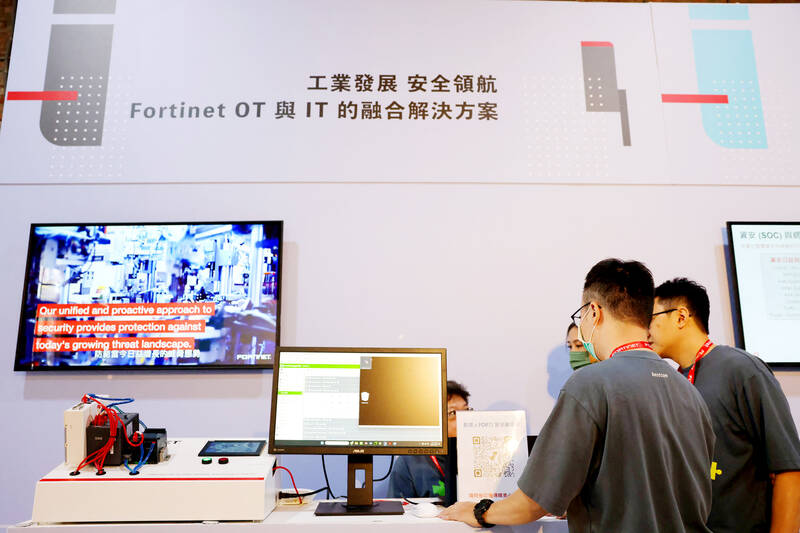Millions of people offline, banks knocked out and the world’s most advanced semiconductor industry paralyzed — Taiwan’s doomsday scenario includes not just invading Chinese troops but also a wave of attacks against its cyber infrastructure.
Taiwan’s security planners run simulated worst-case scenarios constantly to prepare for the day Beijing decides to try and take over.
If China does invade, officials and cybersecurity experts say it will not limit its assaults to security forces and defense infrastructure, but effectively disconnect Taiwan from the world.

Photo: AFP
Taiwan is facing a persistent threat from stealthy attackers who gain access to computer networks to “sit and wait within the victim’s infrastructure”, said Crystal Tu (杜貞儀), a cybersecurity researcher at the Institute of National Defense and Security Research.
They can be highly active during a time of conflict, Tu said, such as a “cyber operation aimed at the disruption of critical infrastructure — including telecommunications, energy and finance sectors.”
Cyberattacks have ramped up dramatically in the year leading up to the presidential and legislative elections today.

Photo: AFP
Taiwanese authorities have said government agencies face an estimated five million cyberattacks a day.
And the cybersecurity firm Fortinet reported an 80 percent increase in cyber attacks in the first half of last year — ranking Taiwan number one in Asia Pacific.
“The cyber operation toward Taiwan never really stops,” said Tu.
Some tactics used against infrastructure have been identified as techniques used by Chinese state-sponsored groups.
Last year, Microsoft flagged the threat from a group named Flax Typhoon that operates out of China and targets Taiwan.
The US tech giant said Flax Typhoon “intends to perform espionage and maintain access” to various Taiwanese organizations for as long as possible.
SEMICONDUCTORS
Cyberattackers have not only targeted the government and defense organizations, but also hit the semiconductor industry.
Taiwanese companies are crucial to the supply of chips, the lifeblood of the global economy.
Such is their importance that one former US official said last year that the US would rather destroy this semiconductor infrastructure than let it fall to invading Chinese forces.
Last year, Taiwan Semiconductor Manufacturing Company (TSMC), which controls more than half of the world’s chip output, reported a data breach at one of its suppliers.
“Taiwan is an important target because it is at the top of the critical high-tech supply chain,” said Fortinet’s Jim Liu. “Geopolitics and (China-Taiwan) relations could inevitably increase cybersecurity incidents.”
China has increased diplomatic and military pressure since 2016, when pro-status quo Tsai Ing-wen (蔡英文) of the Democratic Progressive Party became president, a policy that William Lai (賴清德) is expected to follow.
WORSE CASE SCENARIO
China’s increasing aggression towards Taiwan, including simulated blockades of the island, has fueled speculation among policymakers about Beijing’s potential timeline — and methods — for an invasion.
In the digital realm, officials say China could go beyond cyberattacks and effectively cut off the country from the rest of the world.
“Because Taiwan is an island, all communication with the outside world relies on undersea cables,” said Taiwan’s deputy digital minister Lee Huai-jen (李懷仁).
“The worst-case scenario is all our undersea cables are cut off.”
To prepare for that, Taiwan is looking to the sky.
Lee said that Taiwan is working with two foreign satellite service providers to collaborate with the island’s largest telecom company.
Satellite receivers will be placed in 700 spots across Taiwan “to test whether we can switch communication systems” during times of crisis, he said.
“The first thing... is to maintain the stability of the government’s command system and maintain the accuracy of the information provided” to civilians, he said.

That US assistance was a model for Taiwan’s spectacular development success was early recognized by policymakers and analysts. In a report to the US Congress for the fiscal year 1962, former President John F. Kennedy noted Taiwan’s “rapid economic growth,” was “producing a substantial net gain in living.” Kennedy had a stake in Taiwan’s achievements and the US’ official development assistance (ODA) in general: In September 1961, his entreaty to make the 1960s a “decade of development,” and an accompanying proposal for dedicated legislation to this end, had been formalized by congressional passage of the Foreign Assistance Act. Two

Despite the intense sunshine, we were hardly breaking a sweat as we cruised along the flat, dedicated bike lane, well protected from the heat by a canopy of trees. The electric assist on the bikes likely made a difference, too. Far removed from the bustle and noise of the Taichung traffic, we admired the serene rural scenery, making our way over rivers, alongside rice paddies and through pear orchards. Our route for the day covered two bike paths that connect in Fengyuan District (豐原) and are best done together. The Hou-Feng Bike Path (后豐鐵馬道) runs southward from Houli District (后里) while the

March 31 to April 6 On May 13, 1950, National Taiwan University Hospital otolaryngologist Su You-peng (蘇友鵬) was summoned to the director’s office. He thought someone had complained about him practicing the violin at night, but when he entered the room, he knew something was terribly wrong. He saw several burly men who appeared to be government secret agents, and three other resident doctors: internist Hsu Chiang (許強), dermatologist Hu Pao-chen (胡寶珍) and ophthalmologist Hu Hsin-lin (胡鑫麟). They were handcuffed, herded onto two jeeps and taken to the Secrecy Bureau (保密局) for questioning. Su was still in his doctor’s robes at

Mirror mirror on the wall, what’s the fairest Disney live-action remake of them all? Wait, mirror. Hold on a second. Maybe choosing from the likes of Alice in Wonderland (2010), Mulan (2020) and The Lion King (2019) isn’t such a good idea. Mirror, on second thought, what’s on Netflix? Even the most devoted fans would have to acknowledge that these have not been the most illustrious illustrations of Disney magic. At their best (Pete’s Dragon? Cinderella?) they breathe life into old classics that could use a little updating. At their worst, well, blue Will Smith. Given the rapacious rate of remakes in modern